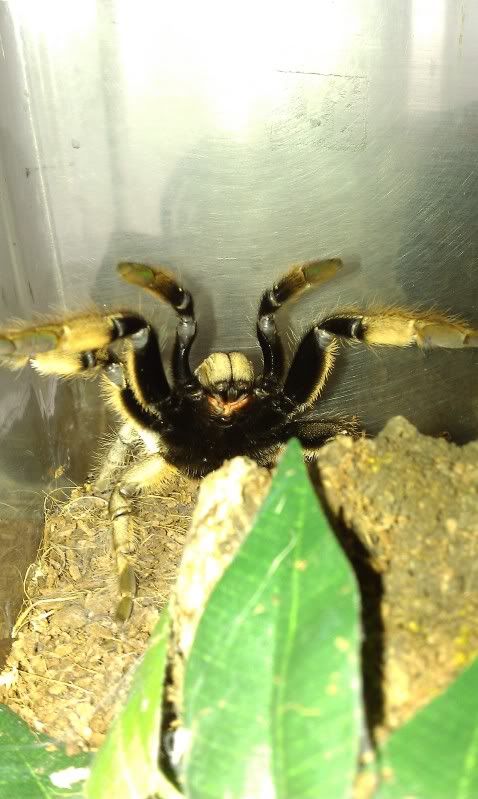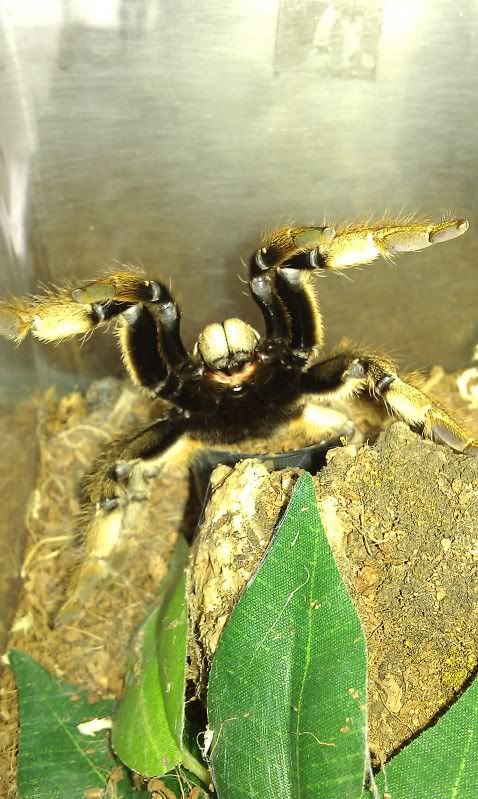- Joined
- Feb 27, 2011
- Messages
- 2,334
I think P. muticus has the least number of traits that you are looking for. So that would leave C. marshalli vs P. lugardi, which look fairly similar imo, except the C. marshalli has the horn, which makes it the winner for me. Can you send me a pm about where you are considering getting a C. marshalli? Its one that I need in my collection. Thanks.So now it's between C. marshalli, P. lugardi and *maybe* P. muticus. I don't want to spend more than 50$ on an unsexed sling. The first two's care regimen is straight foward, I'm not too sure about my third choice.
Woah ! My C. darlingi never made a threat pose while I had it... I never really bothered her except for feeding and watering. I'm guessing your Augacephalus doesn't do this on a regular basisHah. I just went to check on my Augacephalus sp..not happy with water time!



It 'pulled a lividum'!
I highly second this saying!:clap:There are no OW of sorts comparable to a Brachypelma
I have considered P. cancerides many a times, however I've read on several occasions that their venom tends to be more potent than most NW Ts. Any thruth to that ? Other than the venom bit, they are everything I'd want in a T. How likely are they to run after you if pissed off enough ? I definitely wouldn't want an angry 8+" T coming after me during maintenence !Guys, please. Even a remote comparison between a Selenocosmia sp. and a Brachypelma is fairly ridicolous, and dangerous. Pelinobius muticus and Ceratogyrus sp. are not docile and "easy" T's at all as well.
OP: if you are asking for this cause you wanna make a step further with Tarantulas I strongly suggest you get a Phormictopus cancerides (cheap, grows big, vicious eater, but pretty nasty tempered for a NW terrestrial.) or a Chromatopelma cyaneopubescens (Just a bit skittish and pretty fast).
There are no OW of sorts comparable to a Brachypelma
I do not recommend false bottoms for Haplopelma species. As obligate burrowers go, this could be dangerous for cave ins that will badly harm or kill your spider.So I've slept on it some... I could always buy unsexed slings but the chances of rearing out a male really turn me off from doing so. So I'd rather buy confirmed females.
I can go the easy NW way and choose either B. smithi or B. emilia since these two are obviously similar to B. boehmei given they are in the same genus. I ask for personal expenrience if you've owned both, which is less likely to flick for no good reason ?
For the Old World, it's a whole diffrent ballgame, I've ditched the "common traits" for my pick. They've got a 2.5" Haplopelma longipes. What I have in mind is making a false bottom setup in order to keep humidity high as opposed to misting or pouring water on the substrate for humidity, which could very well piss off a Haplopelma to no end. I want to keep disturbances to a strict minimum. I've already tried this before when I kept a P. imperator and worked wonders. I'm wondering if it would be suitable or overkill for a Haplopelma species. My "cage" of choice is the "Kritter Keeper", so that should provide plenty of ventilation, thus hopefully keeping instances of mites, mold or fungus at a minimum.
Thoughts on this ? I've searched for these kinds of setups with Haplopelma and got no results.
actually apart from B. bohemei who was always out, at some phase the rest of my Brachpelma were not out in the open. both of my smithis went on month long burrowing campaigns, although i will admit you will probably be missing those if you are buying larger specimens, since they eventually stopped. not all of my albos are big enough to comment, but similar behaviour is being observed. the 4.5" vagans has liked liked to build a shallow retreat since 1", but is generally out.So that settles it then, more Brachys it is !
But god, I can't for the life of me choose between B. smithi or B. emilia.
To everybody saying that Brachys can be boring, I'll admit they can be, but at least they have the decency of staying in plain sight for the most part as opposed to *most* OW Ts and generally have a good appetite compared with G. rosea (Ugh).
Wait! Don't settle it until you considered C. fimbriatus! I can't believe no one else mentioned them. Mine are on display all the time, have interesting markings, and are some of the best webbers in the entire T world. I believe they would be considered less defensive Old Worlders - mine are anyway. So, I'd say they're at least "comparable" with some aspects of the Brachy.So that settles it then, more Brachys it is !
But god, I can't for the life of me choose between B. smithi or B. emilia.
To everybody saying that Brachys can be boring, I'll admit they can be, but at least they have the decency of staying in plain sight for the most part as opposed to *most* OW Ts and generally have a good appetite compared with G. rosea (Ugh).
Currently the dealer has no C. fimbriatus. I recall being told they are one of the better "starter" OW. Perhaps later on. For now, I'm mostly tilting towards B. smithi because of its docile nature, longevity, decent appetite, lovely colors and last but not least, the fact that it's THE T that started the hobby back in the late '60s/early '70s. On the other hand, I also love the looks of B. emilia. The one thing that keeps me from going straight for one is that I've heard from several people that they can be as "fussy" like G. rosea when it comes to eating. I realize every T has its unique personality, so there may be B. emilias out there that are eating machines. I know my B. boehmei is, but I suspect that's normal for the species.Wait! Don't settle it until you considered C. fimbriatus! I can't believe no one else mentioned them. Mine are on display all the time, have interesting markings, and are some of the best webbers in the entire T world. I believe they would be considered less defensive Old Worlders - mine are anyway. So, I'd say they're at least "comparable" with some aspects of the Brachy.
Wait! Don't settle it until you considered C. fimbriatus! I can't believe no one else mentioned them. Mine are on display all the time, have interesting markings, and are some of the best webbers in the entire T world. I believe they would be considered less defensive Old Worlders - mine are anyway. So, I'd say they're at least "comparable" with some aspects of the Brachy.
Hello, everybody !
First off, a quick background on my experience thus far. I've had my 1st tarantula, a (likely WC) G. rosea in early '09. It was only a year later that I acquired my 2nd T, a then unsexed 1.5" Brachypelma boehmei. It turned out to be female after it molted months later after initial acquisition. Not long after that, I decided to venture into Old World territory and acquired a 1" unsexed Ceratogyrus darlingi which later on turned out to be female as well. Months later acquired unsexed 1.5" B. smithi and N. chromatus. To cut things short, I came across some financial issues so I was forced to sell off most of my Ts. All I kept was the B. boehmei since it has the best lifespan potential.
The B. boehmei is currently in a semi-dedicated closet and recently molted perfectly and reached the 3" mark. I have space for just one more T and would like an Old World T for variety's sake. Is there an Old World species out there that could be considered an equivalent to my B. boehmei ?
Here's the qualities I'm looking for :
Strikingly colorful
Mildly defensive (So that scratches off the OBT/Hmac/Scal)
Doesn't web/hide *too* much
Great eater
Arid Species (So that kinda limits me to mostly baboons, huh ?)
Terrestrial/Opportunistic burrower
A lifespan over at least 10 years for a female
Upon doing much research, one possible answer is Monocentropus balfouri, but I would strongly prefer less expensive alternatives. Then there are others like Pterinochilus lugardi, Ceratogyrus marshalli, Eucratoscelus pachypus and... *maybe* Augacephalus sp. although I don't see these are exceptionally colorful.
Any other ideas ?
Thanks to anyone who can suggest a species that has the majority of those qualities.
-Luc